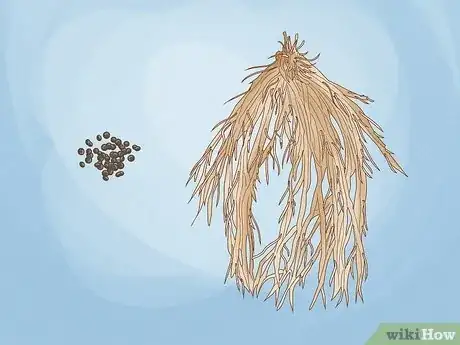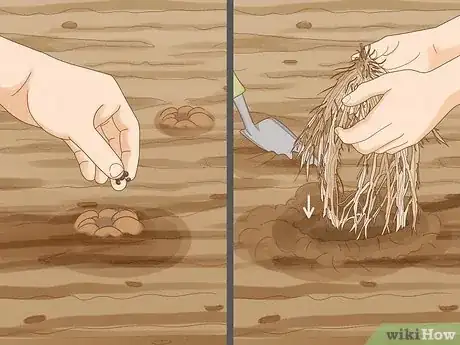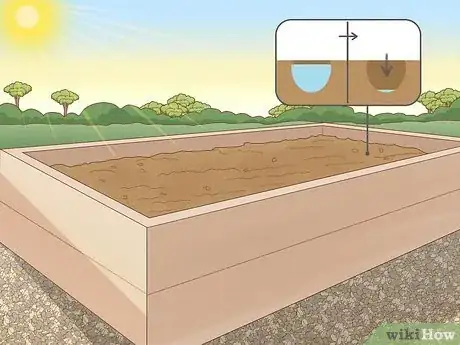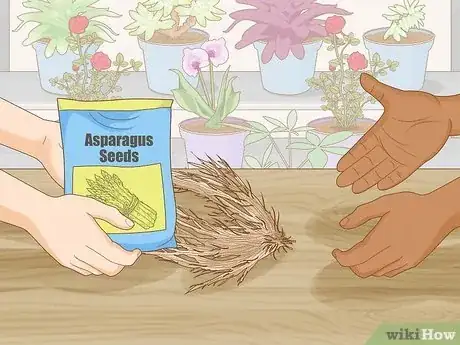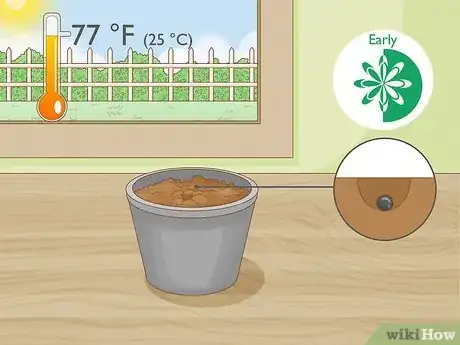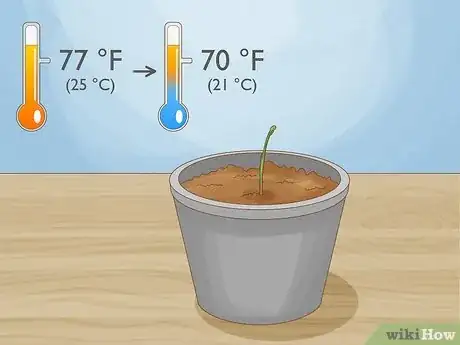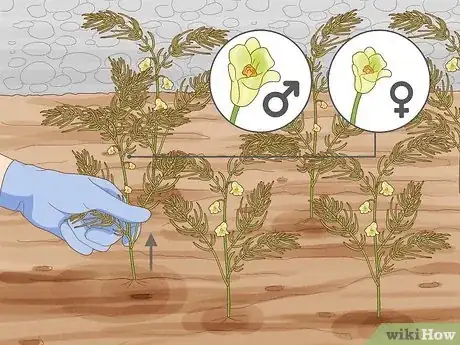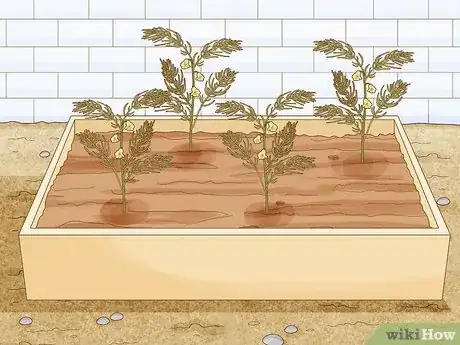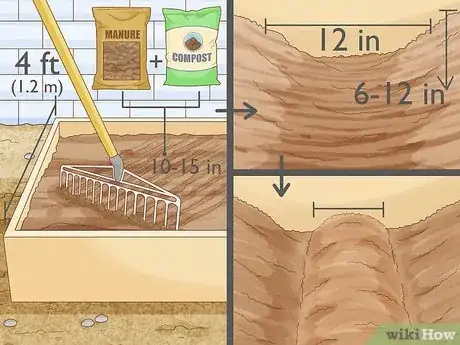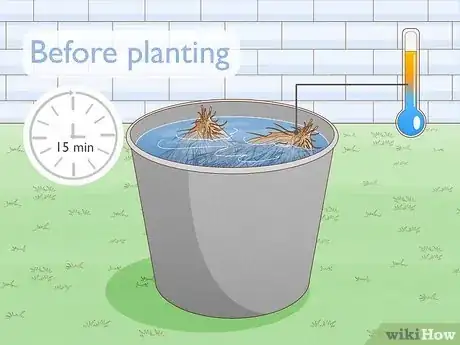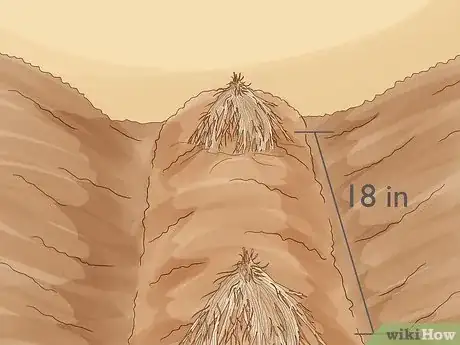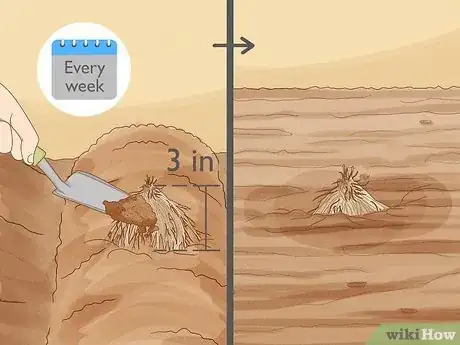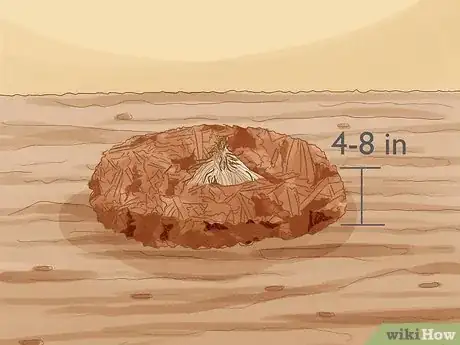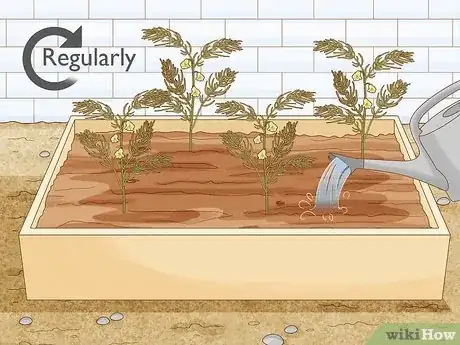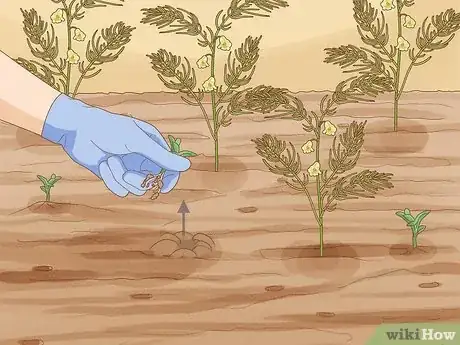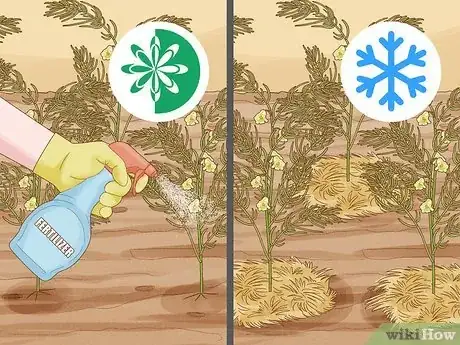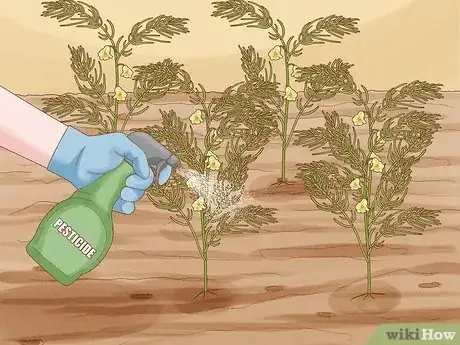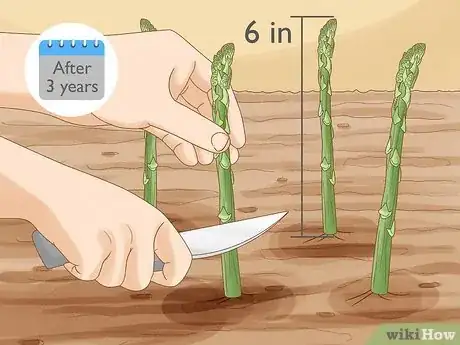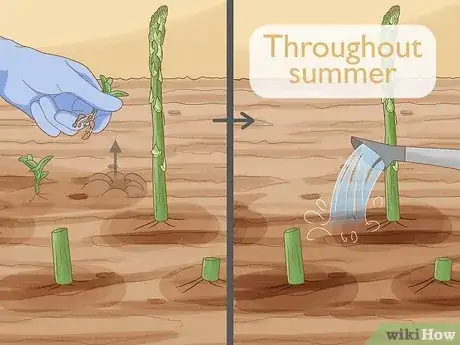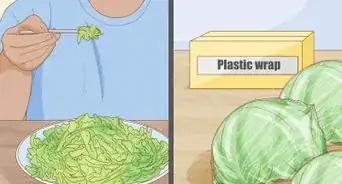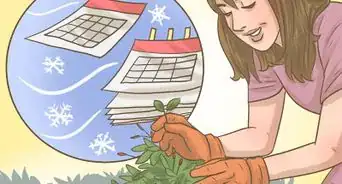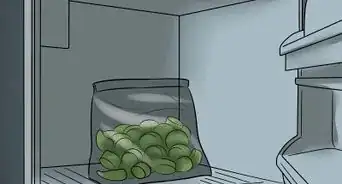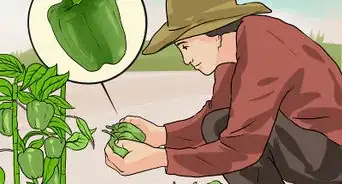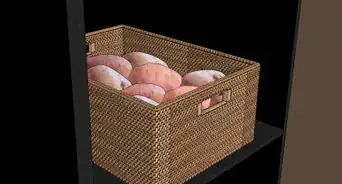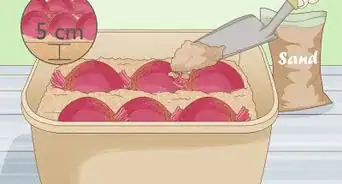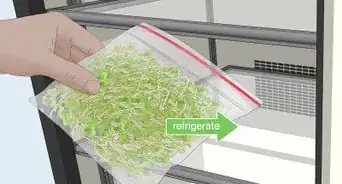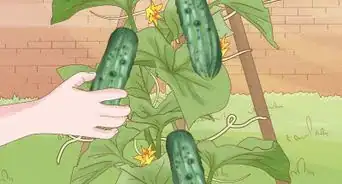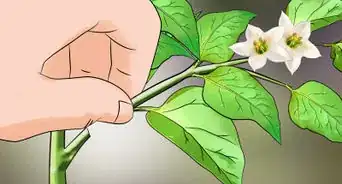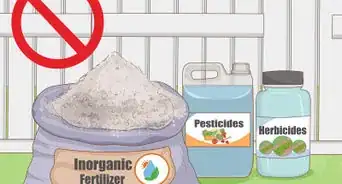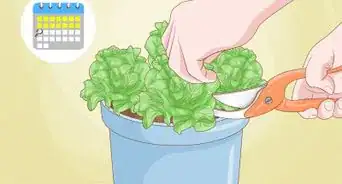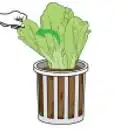This article was co-authored by Andrew Carberry, MPH. Andrew Carberry is a Food Systems Expert and the Senior Program Associate at the Wallace Centere at Winrock International in Little Rock, Arkansas. He has worked in food systems since 2008 and has experience working on farm-to-school projects, food safety programs, and working with local and state coalitions in Arkansas. He is a graduate of the College of William and Mary and holds a Masters degree in public health and nutrition from the University of Tennessee.
There are 8 references cited in this article, which can be found at the bottom of the page.
wikiHow marks an article as reader-approved once it receives enough positive feedback. This article has 18 testimonials from our readers, earning it our reader-approved status.
This article has been viewed 193,768 times.
Asparagus is one of the first green vegetables to come into season at the end of winter, and its presence in markets heralds the start of spring. How do you grow these tender, nutritious stalks in your garden? Start them from seeds, or for faster results, plant their crowns. Once established, asparagus plants produce spears every spring for 12 to 25 years.
Steps
Getting Ready to Plant Asparagus
-
1Find out if asparagus grows well in your region. Asparagus does best in areas that have either cold winters, during which the ground freezes, or very dry summers. It's a hardy and adaptable plant, but it's much harder to grow in areas with mild winters and wet summers, such as the Gulf Coast of the United States.
-
2Decide whether to start your plants from seeds or crowns. Asparagus seeds require three years to grow before they are ready to be harvested. During their first season the seeds germinate and sprout, and after that they need two years to establish their long, spongy roots deep into the soil. When you plant crowns, you skip the first season and go straight to the rooting stage. This means you can lightly harvest your asparagus in the second year, in addition to a full harvest in year three.Advertisement
-
3Asparagus seeds have a low germination rate, so it's more difficult to know exactly how many plants you'll end up with. However, the seeds that do get established tend to turn into hardy plants that last longer and produce more spears than plants that came from crowns.
- Asparagus crowns that are marked "2-year crowns" supposedly allow you to harvest spears just one year after planting. However, the process of transplanting asparagus plants after they've already established their roots can damage them, and they typically still need two full years in the same soil before they reach full production.
-
4Choose a planting spot for your asparagus. Since asparagus can keep producing spears for up to 25 years, choose a spot you're ready to devote to asparagus for a very long time. The area should have the following characteristics:
- Full sun. Asparagus does best in sunny conditions. Since it comes up early in the spring, it's ok to choose a place near trees that don't yet have leaves. Just make sure the asparagus bed isn't shadowed by a group of trees or a building.
- Well-drained soil. The soil should be loose and have excellent drainage. Asparagus planted in waterlogged soil will rot.
- Space for a raised bed. This is optional, since asparagus do fine in the ground, but it's easier to keep their bed free of weeds and completely drained when it's raised.[1]
-
5Buy asparagus seeds or crowns. Asparagus seeds and crowns can be purchased at home and garden stores, nurseries or online. Seeds are available all year round, but crowns are usually for sale very early in the spring, right before they should be planted.
- Asparagus plants are monoecious, meaning that each plant is either male or female. The female plants put energy into producing seeds, so they don't produce as many spears as the males. Some varieties of asparagus have been engineered to produce only male plants. You only need to plant half as many crowns of a male-only variety to get the same yield, since you won't need to weed out the female plants. [2]
- Asparagus seeds aren't usually separated by sex, so the female plants are weeded out once they sprout.
- Choose a rust-resistant variety, such as one of the many "Jersey" varieties or a "Mary Washington." [3]
- If you're buying crowns, pick healthy-looking crowns that are a grayish-brown color, large and plump. Buy them just a day or so before planting them.
- Purple asparagus and other heirloom varieties are available at nurseries. You can create white asparagus by shielding the spears from the sun with soil.
Growing Asparagus from Seeds
-
1Start the seeds indoors. Early in the spring, sow single seeds in small pots meant for starting seedlings. Place the pots in full sunlight, moisten the soil daily, and keep them at a temperature of 77 °F (25 °C).
-
2Lower the temperature when the seeds sprout. Once they have sprouted, they do not need to be kept as warm. Lower the temperature to 70 °F (21 °C).
-
3Plant the seedlings outside. When the seedlings are about a foot tall, and the weather outside has warmed to spring, it's time to plant them outside in a nursery bed. Dig a hole about 3 inches deep to allow them to continue growing.
-
4Weed out the female plants. When the plants begin producing flowers, you'll be able to tell which are male and which are female. The male plants have large, long flowers, and the females have smaller flowers. Pull up the female plants and compost them.[4]
-
5Transplant the male plants to the permanent bed. Let the male plants complete their growing cycle and overwinter in the nursery bed. The following spring, one year from germination, they have reached the same maturity as one-year crowns, and are ready to be transplanted to the permanent bed. Follow the steps below to continue growing the plants.
- Be sure to dig the plants up while they are still dormant. Don't wait until they start their second growing season, or they will suffer from transplant shock.
Planting One-Year Crowns
-
1Prepare the bed. Prepare a bed 4 feet (1.2 m) wide. Remove all traces of weeds and grass from the bed, making sure there are no roots left behind in the soil. Till the soil and rake in manure, compost, blood or bone meal at a depth of 10 to 15 inches (25 to 38 cm).
- Dig trenches for planting. Trenches should be 6 to 12 inches (15 to 30 cm) deep and around 12 inches (30 cm) wide. If you are planting multiple rows, space the trenches 2 to 3 feet (0.6 to 0.9 m) apart.
- Make ridges in the trenches. Mix the soil that you removed from the trenches with organic compost, and spread 2 to 3 inches (5 to 7 cm) of the enriched soil into the bottom center of each trench to form a center ridge.
- You can also mix in rock phosphate, a mineral powder that encourages root growth.[5]
-
2Soak the crowns. Place the crowns in a bucket of either warm water or a compost tea (fortified with plant nutrients) for about 15 minutes before planting.
-
3Plant the crowns. Place the crowns in the trenches, spacing them 18 inches (30 to 45 cm) apart. Drape the roots over the sides of the ridges.
- Cover the roots and crowns with soil. Place soil over the roots and over the crowns by 2 to 3 inches (5 to 7 cm).
- Water the area thoroughly after you are done planting.[6]
-
4Back fill the soil. As the asparagus plants begin to grow and the soil settles, add more soil over the crowns. Place 1 to 3 inches (2 to 7 cm) of soil over the crowns every 2 to 3 weeks until the trenches are filled to ground level.[7]
-
5Mulch the plants. Spread 4 to 8 inches (10 to 20 cm) of mulch around the plants after the trench has been filled. Mulching the plants helps to keep weeds down and helps retain soil moisture.
Caring for the Plants While They Mature
-
1Water the plants regularly. Asparagus plants will reach maturity after two full growing seasons. In the meantime, keep the soil moist at all times.
-
2Weed the soil. Asparagus plants will die if they have to compete for nutrients with weeds, grasses, and any other plants. Take good care of the soil while the plants reach maturity. When they're older, their deep roots will naturally crowd out weeds.
-
3Fertilize and mulch the plants. In spring, fertilize the asparagus plants with a liquid fertilizer meant to stimulate growth. During the winter, protect the plants from the cold by covering them with straw or another mulch.
-
4Watch out for pests and diseases. Asparagus plants are susceptible to asparagus beetles, which feed on the fern-like asparagus foliage during summer and spring. They lay eggs on the asparagus leaves. If you see the beetles or their eggs, pick them off.
Harvesting Asparagus
-
1Pick the spears. After three years, or two if you started the asparagus from crowns, it's time to enjoy your harvest. Cut the spears every few days using a sharp knife or scissors. As your plants produce more spears, you may have to harvest them more often.
- Spears are ready to be harvested when they are about 6 inches (15 cm) high, and the tips begin to loosen.
- Limit the first harvest to two or three weeks, picking spears every few days, and taking care not to pick too many from the same plant. Spears will come up thinner the longer you harvest. A good rule of thumb is to stop harvesting once the spears are about the size of a pencil, allowing the plant to devote energy to its root systems from then on.
- The following year, extend your harvest time to four or five weeks. In the succeeding years, you can extend it to six.[8]
-
2Prepare the plants for next year. At the end of the growing season, stop picking the spears and allow them to grow to their natural height. Keep the asparagus bed weeded, watered, and free of pests throughout the summer. In the fall, cut the fronds down and remove them from the area so no pests will overwinter in the asparagus bed.
Expert Q&A
-
QuestionHow low do you cut asparagus plants in the winter?
 Andrew Carberry, MPHAndrew Carberry is a Food Systems Expert and the Senior Program Associate at the Wallace Centere at Winrock International in Little Rock, Arkansas. He has worked in food systems since 2008 and has experience working on farm-to-school projects, food safety programs, and working with local and state coalitions in Arkansas. He is a graduate of the College of William and Mary and holds a Masters degree in public health and nutrition from the University of Tennessee.
Andrew Carberry, MPHAndrew Carberry is a Food Systems Expert and the Senior Program Associate at the Wallace Centere at Winrock International in Little Rock, Arkansas. He has worked in food systems since 2008 and has experience working on farm-to-school projects, food safety programs, and working with local and state coalitions in Arkansas. He is a graduate of the College of William and Mary and holds a Masters degree in public health and nutrition from the University of Tennessee.
Food Systems Expert Cut the plants down to just above ground level and cover with a few inches of mulch for the winter.
Cut the plants down to just above ground level and cover with a few inches of mulch for the winter. -
QuestionCan you harvest and start new plants with the seeds or berries that the females produce. Should you take them off the plant or collect them after they drop?
 Andrew Carberry, MPHAndrew Carberry is a Food Systems Expert and the Senior Program Associate at the Wallace Centere at Winrock International in Little Rock, Arkansas. He has worked in food systems since 2008 and has experience working on farm-to-school projects, food safety programs, and working with local and state coalitions in Arkansas. He is a graduate of the College of William and Mary and holds a Masters degree in public health and nutrition from the University of Tennessee.
Andrew Carberry, MPHAndrew Carberry is a Food Systems Expert and the Senior Program Associate at the Wallace Centere at Winrock International in Little Rock, Arkansas. He has worked in food systems since 2008 and has experience working on farm-to-school projects, food safety programs, and working with local and state coalitions in Arkansas. He is a graduate of the College of William and Mary and holds a Masters degree in public health and nutrition from the University of Tennessee.
Food Systems Expert Yes, you can harvest the seeds once the berries ripen. Remove the seeds from the berries, wash them well, dry them out and store them until it's time to plant next spring.
Yes, you can harvest the seeds once the berries ripen. Remove the seeds from the berries, wash them well, dry them out and store them until it's time to plant next spring. -
QuestionDo I cut my first year plant at all or should I leave it alone until the next spring?
 Community AnswerWhen the foliage dies in autumn, you can trim it off. Otherwise, don't touch it.
Community AnswerWhen the foliage dies in autumn, you can trim it off. Otherwise, don't touch it.
References
- ↑ http://www.bbc.co.uk/gardening/basics/techniques/growfruitandveg_growingasparagus1.shtml
- ↑ https://garden.org/ideas/view/ediblelandscapingsc/2435/Asparagus-the-Perennial-Vegetable-That-Keeps-Giving/
- ↑ https://garden.org/ideas/view/ediblelandscapingsc/2435/Asparagus-the-Perennial-Vegetable-That-Keeps-Giving/
- ↑ http://www.gardening.cornell.edu/homegardening/scenee3ed.html
- ↑ https://www.rhs.org.uk/advice/profile?pid=310
- ↑ https://www.almanac.com/plant/asparagus
- ↑ https://www.hort.purdue.edu/hort/ext/Pubs/HO/HO_096.pdf
- ↑ https://www.chicagobotanic.org/plantinfo/faq/harvesting_asparagus
- http://www.garden.org/plantguide/?q=show&id=2106
About This Article
To plant asparagus from seeds, start by sowing single seeds in small indoor pots in the early spring. Place the pots in full sunlight, water them daily, and keep them at 77 degrees Fahrenheit. When the seedlings reach 1 foot tall, move them to an outdoor nursery bed and plant them in 3 inch deep holes. Allow the plants to grow for 1 full year, then, in the following spring, move them to a permanent bed. For more tips from our Gardener reviewer, including how to plant one-year crowns, keep reading!

